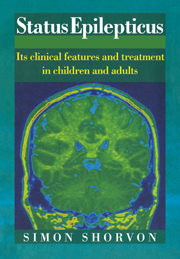Book contents
- Frontmatter
- Contents
- Preface
- 1 The concept of status epilepticus and its history
- 2 Definition, classification and frequency of status epilepticus
- 3 Clinical forms of status epilepticus
- 4 Neurophysiology, neuropathology and neurochemistry of status epilepticus
- 5 Emergency treatment of status epilepticus
- 6 Prognosis and outcome of status epilepticus
- References
- Index
5 - Emergency treatment of status epilepticus
Published online by Cambridge University Press: 15 September 2009
- Frontmatter
- Contents
- Preface
- 1 The concept of status epilepticus and its history
- 2 Definition, classification and frequency of status epilepticus
- 3 Clinical forms of status epilepticus
- 4 Neurophysiology, neuropathology and neurochemistry of status epilepticus
- 5 Emergency treatment of status epilepticus
- 6 Prognosis and outcome of status epilepticus
- References
- Index
Summary
There is not a substance in the materia medica, there is scarcely a substance in the world capable of passing through the gullet of man, that has not at one time or another enjoyed a reputation of being an anti-epileptic
(Edward Sieveking 1857)Sieveking's ironic commentary on the lack of scientific study of therapy in epilepsy is nowhere more pertinent than in the treatment of status. In this chapter I attempt to review objectively the evidence on which to base effective therapy, yet in doing so am aware of the subjective nature of much of this testimony. The main body of this chapter is concerned with the emergency treatment of tonic—clonic status. The specific treatment approaches to the other forms of status are discussed on pp. 287–92.
Tonic—clonic (grand mal) status epilepticus is a feared condition, and rightly so for death or serious morbidity are common sequels. Treatment is urgent because outcome is related directly to the duration of status, and because therapy becomes progressively more hazardous the longer seizures continue. There are two basic objectives in the treatment of status: first, to stop seizure activity as quickly as possible; second, to maintain adequate respiratory and cardiovascular functions (avoiding particularly hypoxia and hypotension), and to minimise the other adverse metabolic, systemic and medical complications.
- Type
- Chapter
- Information
- Status EpilepticusIts Clinical Features and Treatment in Children and Adults, pp. 175 - 292Publisher: Cambridge University PressPrint publication year: 1994
- 6
- Cited by



